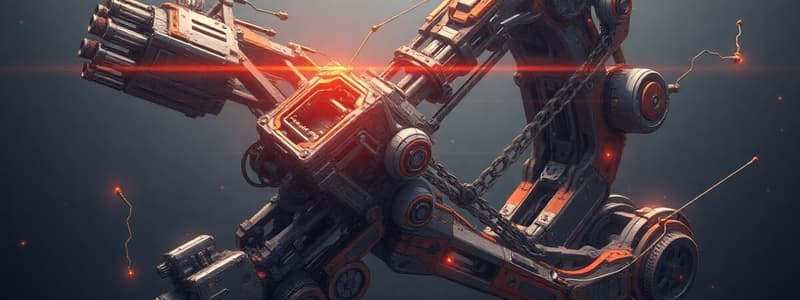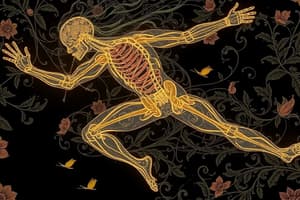Podcast
Questions and Answers
Which of the following best describes the primary focus of 'Science of Mechanism'?
Which of the following best describes the primary focus of 'Science of Mechanism'?
- Calculating forces acting on different machine parts
- Treating the laws governing motion and forces within a machine (correct)
- Analyzing the motion and forms of machine parts
- Designing machines using resistant bodies
In the context of mechanisms, what distinguishes a 'constrained kinematic chain' from an 'unconstrained kinematic chain'?
In the context of mechanisms, what distinguishes a 'constrained kinematic chain' from an 'unconstrained kinematic chain'?
- The predictability of the movements of the links when one is moved. (correct)
- The number of links present in the chain.
- Whether the links are in contact or joined.
- The material composition of the links.
What characteristic defines a 'lower pair' in the context of machine elements?
What characteristic defines a 'lower pair' in the context of machine elements?
- Contact exists at a point or along a line.
- One element not only forms the envelope of the other, but also encloses it, with geometrically identical forms. (correct)
- The pair is formed and maintained due to some external force.
- The pair is formed due to geometrical specifications.
If a mechanism's parts move through a series of repeated movements, with the same order and relations for each repetition, this is best described as:
If a mechanism's parts move through a series of repeated movements, with the same order and relations for each repetition, this is best described as:
Why is it important to use kinematic diagrams?
Why is it important to use kinematic diagrams?
In the context of 'Mechanics of Machinery', what is the main function of a mechanism?
In the context of 'Mechanics of Machinery', what is the main function of a mechanism?
How does a 'form closed pair' differ from a 'forced closed pair'?
How does a 'form closed pair' differ from a 'forced closed pair'?
What is the practical significance of understanding 'degrees of freedom' (DOF) in mechanism design?
What is the practical significance of understanding 'degrees of freedom' (DOF) in mechanism design?
How does 'absolute speed' differ from 'relative speed'?
How does 'absolute speed' differ from 'relative speed'?
Which of these pairs accurately relates to 'Nature of Relative Motion'?
Which of these pairs accurately relates to 'Nature of Relative Motion'?
Flashcards
Science of Mechanism
Science of Mechanism
Treats of the laws governing the motion of the parts of the machine and the forces transmitted by these parts.
Kinematics of Machines
Kinematics of Machines
Treats the motion and forms of the parts of a machine.
Constructive Mechanism or Machine Design
Constructive Mechanism or Machine Design
Involves the calculation of the forces acting on different parts of the machine.
Machine
Machine
Signup and view all the flashcards
Kinematic Diagram
Kinematic Diagram
Signup and view all the flashcards
Links
Links
Signup and view all the flashcards
Frame
Frame
Signup and view all the flashcards
Rigid Link
Rigid Link
Signup and view all the flashcards
Mechanism
Mechanism
Signup and view all the flashcards
Kinematic Chain
Kinematic Chain
Signup and view all the flashcards
Study Notes
ELEMENTS OF MECHANISM
- Science of Mechanism deals with laws governing machine part motion and forces.
- Pure Mechanism/Kinematics treats motion and forms of machine parts.
- Constructive Mechanism/Machine Design calculates forces on machine parts.
- A Machine combines resistant bodies to produce work using mechanical forces.
- A Kinematic Diagram is a skeleton drawing showing dimensions affecting motion.
- Links have motion relative to each other, transmitting forces or controlling motion.
- A Frame is the stationary machine part supporting moving members.
- A Rigid Link's deformations are negligible when determining motion.
- A Mechanism combines rigid bodies/links so motion of one compels others based on the combination.
- A Kinematic Chain connects rigid bodies/links allowing relative motion.
- A Constrained Kinematic Chain has fixed links where movement causes predictable positions of other links.
- An Unconstrained Kinematic Chain has fixed links where movement does not cause predictable positions of other links and it it NOT a mechanism.
- A Lower Pair's element forms the envelope of another with geometrically identical forms.
- A Higher Pair refers to contact at a point or along a line.
- Inversion of Pair exchanges fixedness of an element with its partner.
- Motion is a change of position, relative within knowledge limits.
- A Path traces a line (rectilinear/curvilinear) from a moving point in space.
- Direction and Sense describe a point moving straight, with its direction along the path's line.
- Continuous Motion is when a point moves indefinitely in the same sense along a given path.
- Reciprocating Motion is when a point traverses the same path and reverses direction at the ends.
- Oscillation is reciprocating circular motion, like a pendulum.
- Intermittent Motion is motion interrupted by rest periods.
- Revolution is a circle with all points moving, centered on and perpendicular to an axis.
- Rotation is when the axis passes through the body, like in a wheel, synonymously with revolution.
- An Axis of Rotation/Revolution has unchanging direction, with a fixed axis having constant position and direction.
- A Plane of Rotation/Revolution is perpendicular to the rotation/revolution axis.
- Direction of Rotation/Revolution can be right-handed (clockwise) or left-handed (counter-clockwise).
- Coplanar Motion has all component particles moving in the same or parallel planes.
- A Cycle of Motion is a repeated series of movements in a mechanism, with consistent relations and order.
- A Period of Motion is the time to complete one cycle.
- Linear Speed is the time rate of motion of a point along its path.
- Absolute Speed refers to a fixed reference point.
- Relative Speed refers to a moving reference point.
- Angular Speed is the rate of rotation/revolution around an axis.
- Uniform Speed is when equal spaces are covered in equal times.
- Variable Speed is when equal spaces are NOT covered in equal times.
- Velocity is often synonymous with speed.
- Linear Acceleration is the time rate of change of linear velocity.
- Angular Acceleration is the time rate of change of angular velocity.
- Translational motion have similar velocity as regards direction and speed.
- Rectilinear Translation is when all body components move in a straight line.
- Curvilinear Translation is when all body components move in curved paths.
- All Motion consists of translation, turning (revolving/rotating), or both.
MECHANICS OF MACHINERY
- A Mechanism is assembled to cause constrained and predictable motion to transmit and modify motion.
- Links move relative to each other transmitting forces or controlling motion.
- Joints are connecting points between two or more links.
- A Binary Joint joins two links.
- A Ternary Joint joins three links.
- A Quaternary Joint joins four links.
- Kinematic Pairs combination of two links connected with a joint, allowing relative motion.
- Nature of Relative Motion includes turning, sliding, rolling, screw/helical, and spherical pairs.
- A Turning Pair has one link turning/revolving relative to another.
- A Sliding Pair has one link sliding relative to the other.
- A Rolling Pair has one link rolling relative to the other.
- A Screw/Helical Pair has one link turning and sliding relative to the other.
- A Spherical Pair has one link as a sphere turning inside another's spherical space.
- Constrained Motion is classified as completely, incompletely, or successfully completely constrained.
- Completely Constrained Motion has motion in a defined direction, regardless of force direction.
- Incompletely Constrained Motion allows motion in multiple directions dependent on load direction.
- Successfully Completely Constrained Motion allows motion in one direction using external means.
- Closed Pairs include form and forced closed pairs.
- A Form Closed Pair's link is maintained by its geometry.
- A Forced Closed Pair links is maintained by external force.
- Degrees of Freedom (DOF) includes translational motions along x, y, z axes and rotational motions about x, y, z axes, totals 6.
- Mobility (DOF) of Planar Mechanisms is calculated by the formula: 3(n-1)-2P1-P23(n-1) - 2P_1 - P_2.
Studying That Suits You
Use AI to generate personalized quizzes and flashcards to suit your learning preferences.




